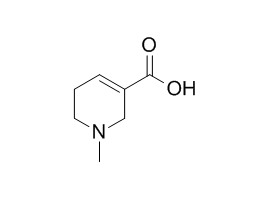Arecaidine
Arecaidine has tumorgenicity.
Inquire / Order:
manager@chemfaces.com
Technical Inquiries:
service@chemfaces.com
Tel:
+86-27-84237783
Fax:
+86-27-84254680
Address:
1 Building, No. 83, CheCheng Rd., Wuhan Economic and Technological Development Zone, Wuhan, Hubei 430056, PRC
Providing storage is as stated on the product vial and the vial is kept tightly sealed, the product can be stored for up to
24 months(2-8C).
Wherever possible, you should prepare and use solutions on the same day. However, if you need to make up stock solutions in advance, we recommend that you store the solution as aliquots in tightly sealed vials at -20C. Generally, these will be useable for up to two weeks. Before use, and prior to opening the vial we recommend that you allow your product to equilibrate to room temperature for at least 1 hour.
Need more advice on solubility, usage and handling? Please email to: service@chemfaces.com
The packaging of the product may have turned upside down during transportation, resulting in the natural compounds adhering to the neck or cap of the vial. take the vial out of its packaging and gently shake to let the compounds fall to the bottom of the vial. for liquid products, centrifuge at 200-500 RPM to gather the liquid at the bottom of the vial. try to avoid loss or contamination during handling.
Food Chem.2023, 424:136383.
Front Pharmacol.2024, 15:1439079.
Phytomedicine.2024, 155760.
Chem Biol Interact.2018, 283:59-74
Hum Exp Toxicol.2022, 41:9603271221143713.
Korean J. Food Sci. & Technol.2022, 54(2):241-246
Heliyon.2023, 9(11):e21944.
ACS Omega.2023, 8(36):32424-32431.
Int J Mol Sci.2022, 23(23):14545.
Biomedicines.2024, 12(3):495.
Related and Featured Products
Brain Res. 1977 Nov 18;136(3):513-22.
Effects of the Areca nut constituents arecaidine and guvacine on the action of GABA in the cat central nervous system.[Pubmed:
922499 ]
Arecaidine and guvacine, constituents of the nut of Areca catechu, inhibited the uptake of GABA and beta-alanine, but not that of glycine, by slices of cat spinal cord.
METHODS AND RESULTS:
In cats anesthetised with pentobarbitone, electrophoretic Arecaidine enhanced the inhibitory actions of GABA and beta-alanine, but not those of glycine or taurine, on the firing of spinal neurones. Similarly, electrophoretic guvacine enhanced the inhibition of spinal neurones by GABA but not that by glycine. The uptake of GABA by slices of cat cerebellum was inhibited by Arecaidine, and the effect of electrophoretic GABA on the firing of cerebellar Purkinje cells was enhanced by electrophoretic Arecaidine.
When administered intravenously Arecaidine failed to affect synaptic inhibitions considered to be mediated by GABA. Intravenous Arecaidine had no effect on either spinal prolonged (presynaptic) inhibition (20mg/kg), dorsal root potentials (20mg/kg) or basket cell inhibition of Purkinje cells (250 mg/kg), although topical Arecaidine (6.6-10 x 10(-3) M) blocked this latter inhibition.
CONCLUSIONS:
Large doses of Arecaidine (1 g/kg subcutaneous) marginally reduced the lethal effects of bicuculline in mice but appeared to have little or no anticonvulsant activity.
J Pharm Pharmacol. 2013 Apr;65(4):582-90.
Transport of the areca nut alkaloid arecaidine by the human proton-coupled amino acid transporter 1 (hPAT1).[Pubmed:
23488788 ]
The pyridine alkaloid Arecaidine is an ingredient of areca nut preparations. It is responsible for many physiological effects observed during areca nut chewing. However, the mechanism underlying its oral bioavailability has not yet been studied. We investigated whether the H⁺-coupled amino acid transporter 1 (PAT1, SLC36A1), which is expressed in the intestinal epithelium, accepts Arecaidine, arecoline, isoguvacine and other derivatives as substrates.
METHODS AND RESULTS:
Inhibition of L-[³H]proline uptake by Arecaidine and derivatives was determined in Caco-2 cells expressing hPAT1 constitutively and in HeLa cells transiently transfected with hPAT1-cDNA. Transmembrane transport of Arecaidine and derivatives was measured electrophysiologically in Xenopus laevis oocytes.
Arecaidine, guvacine and isoguvacine but not arecoline strongly inhibited the uptake of L-[³H]proline into Caco-2 cells. Kinetic analyses revealed the competitive manner of L-proline uptake inhibition by Arecaidine. In HeLa cells transfected with hPAT1-cDNA an affinity constant of 3.8 mm was obtained for Arecaidine. Electrophysiological measurements at hPAT1-expressing X. laevis oocytes demonstrated that Arecaidine, guvacine and isoguvacine are transported by hPAT1 in an electrogenic manner.
CONCLUSIONS:
We conclude that hPAT1 transports Arecaidine, guvacine and isoguvacine across the apical membrane of enterocytes and that hPAT1 might be responsible for the intestinal absorption of these drug candidates.
J Oral Pathol Med. 1996 Feb;25(2):65-8.
Diffusion of reduced arecoline and arecaidine through human vaginal and buccal mucosa.[Pubmed:
8667258 ]
The purpose of the present study was to determine the minimal Arecaidine concentrations showing a synergistic effect on DMBA-induced hamster cheek pouch carcinogenesis.
METHODS AND RESULTS:
One hundred and twelve male adult Syrian golden hamsters were divided into 16 groups, each containing seven animals. After eight weeks of DMBA initiation and then four weeks of Arecaidine promotion, 100% tumor incidence was found with Arecaidine concentrations of 400 micrograms/ml and 500 micrograms/ml; average tumor numbers were 1.86 +/- 0.63 and 1.86 +/- 0.93 respectively (P < 0.05). After four weeks of DMBA and a subsequent eight weeks of Arecaidine painting, all hamsters developed visible tumors with Arecaidine concentrations of 900 micrograms/ml and 1000 micrograms/ml; average tumor numbers were 1.86 +/- 0.82 and 2.14 +/- 1.09 respectively (P < 0.05). The tumor dimensions varied little and differences were not statistically significant. Without DMBA pretreatment, regardless of the high Arecaidine concentrations (1000 micrograms/ml, 2000 micrograms/ml and 3000 micrograms/ml) applied, no visible tumor growth was observed; only hyperkeratosis and inflammation could be discerned histologically.
CONCLUSIONS:
Thus, the minimal concentrations of Arecaidine displaying a synergistic effect in the DMBA-induced hamster cheek pouch of carcinogenesis were found to be 400 micrograms/ ml applied for four weeks after eight weeks of DMBA application, and 900 micrograms/ml applied for eight weeks after four weeks of DMBA painting. These findings may be useful for other studies concerning the tumorgenicity of Arecaidine.



